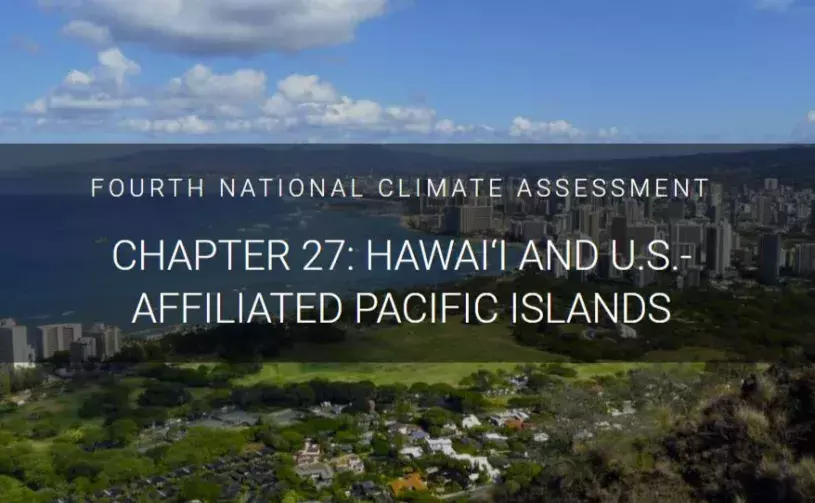Error message

Pacific islands are particularly vulnerable to climate change impacts due to their exposure and isolation, small size, low elevation (in the case of atolls), and concentration of infrastructure and economy along the coasts.
On islands, all natural sources of freshwater come from rainfall received within their limited land areas. Severe droughts are common, making water shortage one of the most important climate-related risks in the region. As temperature continues to rise and cloud cover decreases in some areas, evaporation is expected to increase, causing both reduced water supply and higher water demand.
The impacts of sea level rise in the Pacific include coastal erosion, episodic flooding, permanent inundation, heightened exposure to marine hazards, and saltwater intrusion to surface water and groundwater systems. Sea level rise will disproportionately affect the tropical Pacific and potentially exceed the global average.
Invasive species, landscape change, habitat alteration, and reduced resilience have resulted in extinctions and diminished ecosystem function. Wildlife that relies on coastal habitats will likely also be severely impacted. In Hawaiʻi, coral reefs contribute an estimated $477 million to the local economy every year. Under projected warming of approximately 0.5°F per decade, all nearshore coral reefs in the Hawai‘i and Pacific Islands region will experience annual bleaching before 2050. An ecosystem-based approach to international management of open ocean fisheries in the Pacific that incorporates climate-informed catch limits is expected to produce more realistic future harvest levels and enhance ecosystem resilience.
Emerging issues for Indigenous communities of the Pacific include the resilience of marine-managed areas and climate-induced human migration from their traditional lands. The rich body of traditional knowledge is place-based and localized and is useful in adaptation planning because it builds on intergenerational sharing of observations. Documenting the kinds of governance structures or decision-making hierarchies created for management of these lands and waters is important as a learning tool that can be shared with other island communities.
Across the region, groups are coming together to minimize damage and disruption from coastal flooding and inundation as well as other climate-related impacts. Social cohesion is already strong in many communities, making it possible to work together to take action. Early intervention can lower economic, environmental, social, and cultural costs and reduce or prevent conflict and displacement from ancestral land and resources.
To explore the NCA chapter online, go to: https://nca2018.globalchange.gov/chapter/27/.
Pacific islands are particularly vulnerable to climate change impacts due to their exposure and isolation, small size, low elevation (in the case of atolls), and concentration of infrastructure and economy along the coasts.
On islands, all natural sources of freshwater come from rainfall received within their limited land areas. Severe droughts are common, making water shortage one of the most important climate-related risks in the region. As temperature continues to rise and cloud cover decreases in some areas, evaporation is expected to increase, causing both reduced water supply and higher water demand.
The impacts of sea level rise in the Pacific include coastal erosion, episodic flooding, permanent inundation, heightened exposure to marine hazards, and saltwater intrusion to surface water and groundwater systems. Sea level rise will disproportionately affect the tropical Pacific and potentially exceed the global average.
Invasive species, landscape change, habitat alteration, and reduced resilience have resulted in extinctions and diminished ecosystem function. Wildlife that relies on coastal habitats will likely also be severely impacted. In Hawaiʻi, coral reefs contribute an estimated $477 million to the local economy every year. Under projected warming of approximately 0.5°F per decade, all nearshore coral reefs in the Hawai‘i and Pacific Islands region will experience annual bleaching before 2050. An ecosystem-based approach to international management of open ocean fisheries in the Pacific that incorporates climate-informed catch limits is expected to produce more realistic future harvest levels and enhance ecosystem resilience.
Emerging issues for Indigenous communities of the Pacific include the resilience of marine-managed areas and climate-induced human migration from their traditional lands. The rich body of traditional knowledge is place-based and localized and is useful in adaptation planning because it builds on intergenerational sharing of observations. Documenting the kinds of governance structures or decision-making hierarchies created for management of these lands and waters is important as a learning tool that can be shared with other island communities.
Across the region, groups are coming together to minimize damage and disruption from coastal flooding and inundation as well as other climate-related impacts. Social cohesion is already strong in many communities, making it possible to work together to take action. Early intervention can lower economic, environmental, social, and cultural costs and reduce or prevent conflict and displacement from ancestral land and resources.
To explore the NCA chapter online, go to: https://nca2018.globalchange.gov/chapter/27/.




